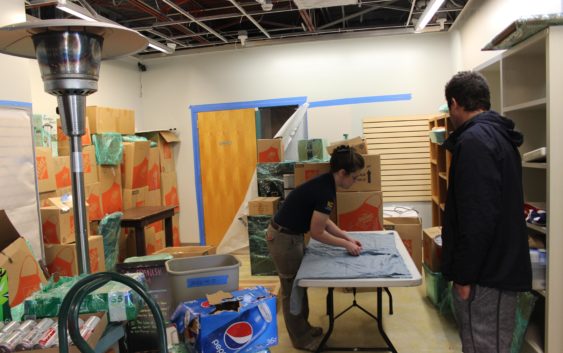- National memorial to honor NC firefighter who died on duty during Hurricane Helene
- Gov. Josh Stein extends State of Emergency for western NC wildfires
- Governor Stein extends state of emergency for NC wildfire threat
- Governor Stein extends emergency in 34 NC counties amid wildfire threat
- Texans can buy emergency preparation supplies tax-free April 26-28 ahead of severe weather season
Recovery slow at Hurricane Florence-battered Brunswick Town

BRUNSWICK COUNTY — It’s a sunny afternoon, the weather is warm, and many schools are out for spring break.
But the parking lot at the Brunswick Town/Fort Anderson State Historic Site stood empty last week except for three cars belonging to staff members. In the span of two hours, only two cars pull into the parking lot. The visitors — two couples — wander the grounds. One of the women approaches the museum building and presses her face to the glass to see inside.
Site manager Jim McKee sees the woman peering inside and heads over to open the front door, but remembers that it remains broken.
“The building’s still closed, but you’re welcome to explore the grounds,” he calls through the glass.
Battered by Hurricane Florence last September, the grounds officially re-opened on Dec. 4. The museum is scheduled to re-open this Saturday.
After the storm, it only took about a week for mold to grow on the ceiling, walls and floors. Grayish-green mold also bloomed on the reception desk and staff’s personal items, such as books and interpretive clothing. The museum, which featured a large artificial tree with felt foliage, was most affected by the fungus.
Shannon Walker, one of the site’s historic interpreters, compared the building’s construction to that of a terrarium.
“You’ve got this concrete floor where moisture’s coming up, and you have your ceiling, of course, and with no air circulation, all this humidity just sits,” she said. “So even though water didn’t get in the building, water was still there. It was just in the air.”
Despite the humid conditions, the artifacts remained untouched. Nearly all are encased in glass, and the cases created their own micro-environments. Throughout the remainder of the building, which includes the gift shop, the auditorium, and staff offices, staff says the mold was “horrible.”
“You could actually watch it grow,” McKee said.
Mold remediation began the first week in October and was completed two days before Thanksgiving. Since then, staff has been working to get the building back in order. McKee plans to allow the public inside for the first time this Saturday.
“We’ll have the lobby and the museum open,” he said. “As you can see, these are the only two rooms that have floors.”
‘It was bad’
Despite the progress, things have been difficult for staff since the hurricane. McKee recalled driving to the site the day after Florence made landfall to survey the damage.
“The closer I got to the site, the worse it got,” he recalled.
McKee found the ground was cluttered with limbs, branches, downed trees and power lines. The water from Orton Pond had nearly reached the roadway. McKee toured the site by tractor to avoid the alligators that had come to enjoy the feast of frogs that had sought higher ground.
“It was bad,” he said. “There were trees and limbs everywhere. The boardwalk was flooded. I couldn’t even access the waterfront.”
The next day, the dam in Orton Pond burst. McKee didn’t see the site again for several days. That time, he surveyed the damage by boat. The site encompasses about 120 acres, and of that land, about 50 acres are maintained.
“In the public areas alone, we had over 50 trees down,” McKee said.
Once the site was accessible, crews worked to clear the ground in the public areas. The only traces of the storm are now debris piles. McKee plans to use the large, gnarly tree trunks for firewood.
“The rest of it, we’re going to have milled into lumber to make a new visitors’ services desk and interpretive furniture,” he said.
Long road ahead
Even after the museum re-opens Saturday, McKee says complete recovery will take at least a year. Currently, there is no timeline for reconstruction inside the building.
“Essentially, we’re waiting on (the Federal Emergency Management Agency). Because of the storm and the damage it did in southeastern North Carolina, all the emergency money just got spent right away,” he said. “So, the money that we got to do the mold remediation was for an emergency; it had to be done. Unfortunately, money for the rebuild is just not there.”
In addition to damaging the site’s facilities, Florence also made a significant impact on the site’s visitor traffic. Even after the grounds re-opened, staff said visitors have been slow to come back. Walker attributes some of that to the weather, noting it rained during the site’s first two events since the storm. Staff is hoping for clear skies for Bartram Day this Saturday.
Visitors are crucial to the site because a significant portion of the budget comes from donations and gift shop sales. McKee said that’s why it’s difficult to quantify the storm’s financial impact.
“We’ll never know how many visitors we had to turn away from the site because it was closed, and we’ll probably never know the full impact of Florence,” McKee said.
But what he does know is that the site will continue to be a symbol of Brunswick County — past, present and future.
“It’s going to come back, and it’s going be better than it was,” McKee promised.
Reporter Renee Spencer can be reached at 910-343-2364 or rspencer@starnewsonline.com.